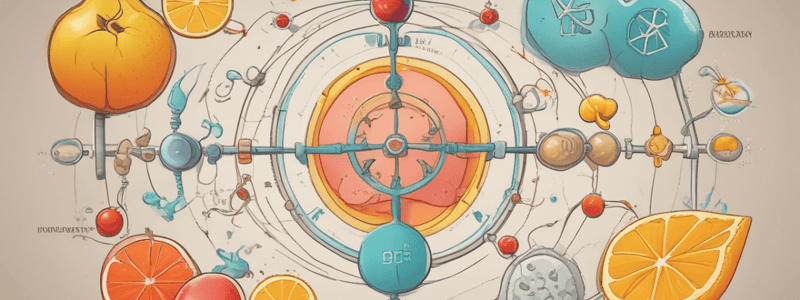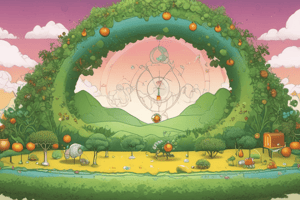Podcast
Questions and Answers
What is the primary function of catabolism in cells?
What is the primary function of catabolism in cells?
- To synthesize macromolecules
- To break down macromolecules to produce energy (correct)
- To regulate anabolic pathways
- To store energy in the form of ATP
What is the term for the energy currency of the cell?
What is the term for the energy currency of the cell?
- ADP
- ATP (correct)
- NADP
- AMP
What is the primary purpose of glycolysis?
What is the primary purpose of glycolysis?
- To synthesize glucose
- To store energy in the form of ATP
- To break down glucose to produce energy (correct)
- To regulate anabolic pathways
What is the term for the sum of all reactions in a cell?
What is the term for the sum of all reactions in a cell?
What type of bond joins the first phosphoryl group to the 5-carbon sugar ribose in ATP?
What type of bond joins the first phosphoryl group to the 5-carbon sugar ribose in ATP?
What is the term for the sequence of metabolic reactions?
What is the term for the sequence of metabolic reactions?
What is the term for the process of using energy to make macromolecules?
What is the term for the process of using energy to make macromolecules?
What is the primary purpose of Stage I in catabolism?
What is the primary purpose of Stage I in catabolism?
What is the molecule composed of in ATP?
What is the molecule composed of in ATP?
What is the type of bond that joins the second and third phosphoryl groups in ATP?
What is the type of bond that joins the second and third phosphoryl groups in ATP?
Which enzyme is responsible for breaking down starch into monosaccharides in the mouth?
Which enzyme is responsible for breaking down starch into monosaccharides in the mouth?
What is the primary product of the breakdown of fats in the small intestine?
What is the primary product of the breakdown of fats in the small intestine?
What is the purpose of Stage 2 in catabolism?
What is the purpose of Stage 2 in catabolism?
What is the byproduct of the oxidation of the acetyl group in the citric acid cycle?
What is the byproduct of the oxidation of the acetyl group in the citric acid cycle?
What is the role of glycolysis in glucose metabolism?
What is the role of glycolysis in glucose metabolism?
What is the fate of pyruvate after glycolysis?
What is the fate of pyruvate after glycolysis?
What is the primary energy source that is most readily used by the body?
What is the primary energy source that is most readily used by the body?
What is the final product of the complete oxidation of nutrients in the citric acid cycle?
What is the final product of the complete oxidation of nutrients in the citric acid cycle?
What is the primary purpose of allosteric control in glycolysis?
What is the primary purpose of allosteric control in glycolysis?
In which condition is pyruvate converted to lactic acid?
In which condition is pyruvate converted to lactic acid?
What is the ultimate fate of pyruvate in the presence of oxygen?
What is the ultimate fate of pyruvate in the presence of oxygen?
Which enzyme is not a site of allosteric control in glycolysis?
Which enzyme is not a site of allosteric control in glycolysis?
What is the purpose of recycling NAD+?
What is the purpose of recycling NAD+?
In which organism is pyruvate converted to ethanol?
In which organism is pyruvate converted to ethanol?
What is the role of hexokinase in glycolysis?
What is the role of hexokinase in glycolysis?
What is the fate of pyruvate in the citric acid cycle?
What is the fate of pyruvate in the citric acid cycle?
Why is pyruvate transported to the mitochondria?
Why is pyruvate transported to the mitochondria?
What are the three enzymes that catalyze reactions with large decreases in free energy in glycolysis?
What are the three enzymes that catalyze reactions with large decreases in free energy in glycolysis?
What is the primary function of catabolic pathways in cells?
What is the primary function of catabolic pathways in cells?
What is the energy currency that cells use to perform various cellular functions?
What is the energy currency that cells use to perform various cellular functions?
What is the process of glycolysis involved in?
What is the process of glycolysis involved in?
What is the term for the sum of all reactions in a cell?
What is the term for the sum of all reactions in a cell?
What type of bonds are used to join the second and third phosphoryl groups in ATP?
What type of bonds are used to join the second and third phosphoryl groups in ATP?
What is the purpose of the energy conversion strategy used by cells?
What is the purpose of the energy conversion strategy used by cells?
What are the two types of cellular work that require energy?
What are the two types of cellular work that require energy?
What is the sequence of metabolic reactions called?
What is the sequence of metabolic reactions called?
What is the energy released from the breakdown of glucose used for?
What is the energy released from the breakdown of glucose used for?
What is the primary purpose of Stage I in catabolism?
What is the primary purpose of Stage I in catabolism?
What is the fate of the acetyl group in the citric acid cycle?
What is the fate of the acetyl group in the citric acid cycle?
What is the primary function of glycolysis in glucose metabolism?
What is the primary function of glycolysis in glucose metabolism?
What is the role of bile salts in the digestion of fats?
What is the role of bile salts in the digestion of fats?
What is the end product of the complete oxidation of nutrients in the citric acid cycle?
What is the end product of the complete oxidation of nutrients in the citric acid cycle?
What is the primary energy source that is most readily used by the body?
What is the primary energy source that is most readily used by the body?
What is the purpose of Stage 3 in catabolism?
What is the purpose of Stage 3 in catabolism?
What is the fate of pyruvate after glycolysis?
What is the fate of pyruvate after glycolysis?
What is the primary function of pancreatic amylase in the digestion of carbohydrates?
What is the primary function of pancreatic amylase in the digestion of carbohydrates?
What happens to pyruvate in the absence of oxygen in mammalian cells?
What happens to pyruvate in the absence of oxygen in mammalian cells?
Which enzyme is responsible for a site of allosteric control in glycolysis?
Which enzyme is responsible for a site of allosteric control in glycolysis?
What is the fate of pyruvate in the presence of oxygen in yeast?
What is the fate of pyruvate in the presence of oxygen in yeast?
Why is NAD+ recycled in glycolysis?
Why is NAD+ recycled in glycolysis?
What is the end product of glycolysis in aerobic conditions?
What is the end product of glycolysis in aerobic conditions?
What is the role of pyruvate kinase in glycolysis?
What is the role of pyruvate kinase in glycolysis?
In which organ does glycolysis take place?
In which organ does glycolysis take place?
What is the purpose of glycolysis in cellular respiration?
What is the purpose of glycolysis in cellular respiration?
What is the fate of pyruvate in anaerobic conditions in yeast?
What is the fate of pyruvate in anaerobic conditions in yeast?
What is the significance of the three reactions with large decreases in free energy in glycolysis?
What is the significance of the three reactions with large decreases in free energy in glycolysis?
Flashcards are hidden until you start studying




